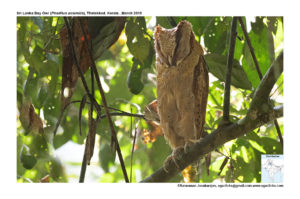
Sri Lanka Bay Owl Phodilus badius assimilis
Etymology:
- Phodilus : Greek word phos- daylight; deilostimid,cowardly
- Badius : Latin for Chestnut-coloured, Brown
- Assimilis: Latin for Similar
Distribution in India: Resident of South West India.
Description: Size of 22–27 cm; wt. of 230 g . It is a smallish owl with short legs and wings, short ear-tufts, “vee” shaped frontal shield and large eyes. The upperparts are darker and browner, with heavier spotting of black and white; remiges and rectrices are more heavily barred; frontal shield is vinaceous pink.Both the sexes are alike; irides are dark brown; bill is yellowish; toes are pale greyish-brown. The juvenile isun-described yet.
Habitat: It is found in wet evergreen and mixed evergreen-deciduous forest, mangroves, partially harvested forest, on level terrain and in foothills. It roosts on horizontal branches during daytime. It is found from sea-level to 1100 m in India, occasionally as high as 2220 m in Sri Lanka.
Food Habits: It strictly nocturnal. It hunts from perch beneath forest canopy, and takes a variety of nocturnal rodents and invertebrates. While roosting it adopts a camouflage pose in ‘alert mode’ .It does this by assuming a shape which disguises it as a broken branch or stump. The outline of the body is quickly changed from a somewhat plump to a slender shape. The change is effected by tightening of the body, or contour, feathers.
Breeding Habits: They breed in Nov. The courting involves distinctive song consisting of multiple whistles with inflections. They nest in tree holes. They lay a clutch of 2-3 eggs.The eggs hatch asynchronously.